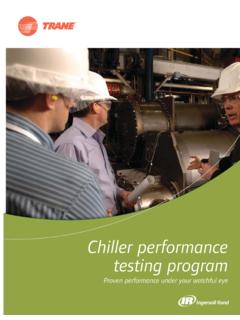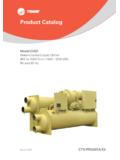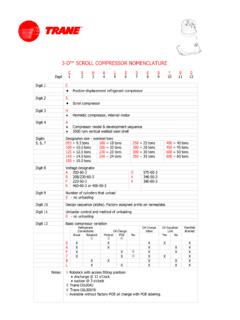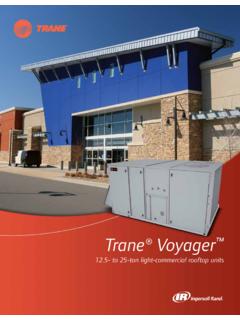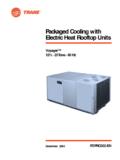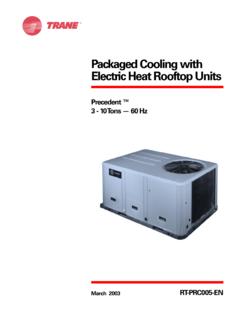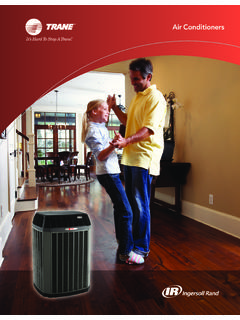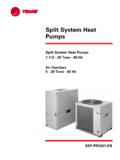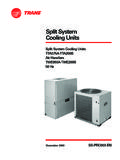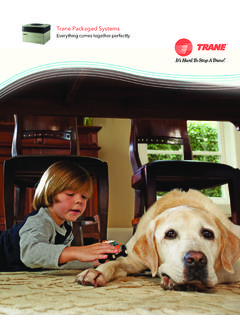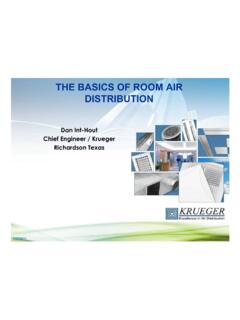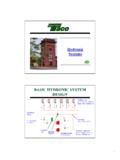Transcription of Dedicated Outdoor Air Systems - Trane
1 Dedicated Outdoor Air Systems Trane DX Outdoor Air UnitApplication GuideMay 2020 SYS-APG001C-ENproduct image goes here, centered on pageSAFETY WARNINGOnly qualified personnel should install and service the equipment. The installation, starting up, and servicing of heating, ventilating, and air-conditioning equipment can be hazardous and requires specific knowledge and training. Improperly installed, adjusted or altered equipment by an unqualified person could result in death or serious injury. When working on the equipment, observe all precautions in the literature and on the tags, stickers, and labels that are attached to the equipment. 2020 Trane All rights reservedDedicated Outdoor Air Systems : Trane DX Outdoor Air Unit SYS-APG001C-ENPrefaceAs a leading HVAC manufacturer, we deem it our responsibility to serve the building industry by regularly disseminating information that promotes the effective application of building comfort Systems .
2 For that reason, we regularly publish educational materials, such as this one, to share information gathered from laboratory research, testing programs, and practical guide discusses HVAC Systems that use: a Dedicated Outdoor air unit to treat all of the Outdoor air brought into thebuilding for ventilation, and .. zone-mounted terminal units to treat the indoor the Outdoor air separately from recirculated return air makes it easy to verify sufficient ventilation airflow and enables enforcement of a maximum humidity limit in occupied more information on Dedicated Outdoor air Systems (DOAS), refer to the following: Dehumidification in HVAC Systems , Trane application manual(SYS-APM004-EN) Dedicated Outdoor Air Equipment, Trane Engineers Newsletter Liveprogram (DVD; APP-CMC043-EN) Water-Source and Ground-SourceHeat Pump Systems , Traneapplication manual (SYS-APM010-EN) Dedicated Outdoor Air Systems ASHRAE webcast, 2012( ) Trane , in proposing these system design and application concepts, assumes no responsibility for the performance or desirability of any resulting system design.
3 Design of the HVAC system is the prerogative and responsibility of the engineering and the Trane logo are trademarks of Trane in the United States and other countries. All trademarks referenced in this document are the trademarks of their respective Outdoor Air Systems : Trane DX Outdoor Air UnitSYS-APG001C-ENTable of ContentsDefining the Dehumidification Challenge .. 1 Dedicated OA System Configurations .. 2 Comparison of Different Dedicated OA System Configurations .. 3 Cold or Neutral Air? .. 5 Designing a Dedicated OA System .. 8 Selecting the Dedicated OA Unit .. 8 Control of the Dedicated OA Unit .. 13 Dehumidification mode .. 14 Sensible cooling mode .. 14 Sensible heating mode .. 15 Ventilation only mode .. 15 References .. 16 SYS-APG001C-ENDedicated Outdoor Air Systems : Trane DX Outdoor Air Unit1 Defining the Dehumidification ChallengeBuilding professionals expend much time and effort to design HVAC Systems that handle both ventilation and dehumidification.
4 High-occupancy spaces, such as classrooms, pose a particular challenge especially when the system of choice delivers a constant-volume mixture of Outdoor and recirculated return air. Why? The answer lies in the fact that the sensible- and latent-cooling loads on the HVAC equipment do not peak at the same it s hot outside, the sensible-cooling load often far exceeds the latent-cooling load (Figure 1). By contrast, when it s cooler but humid outside, the latent-cooling load can approach or even exceed the sensible-cooling HVAC equipment traditionally is selected with sufficient cooling capacity to handle the design load at the peak Outdoor dry-bulb condition and controlled by a thermostat that matches the sensible-cooling capacity of the coil with the sensible-cooling load in the space. Therefore, as the sensible-cooling load in the space decreases, the cooling capacity (both sensible and latent) provided by the HVAC equipment also decreases.
5 In most climates, the combination of less latent-cooling capacity and a lower SHR (sensible-heat ratio) in the space elevates the indoor humidity level at part-load off-the-shelf, packaged unitary air conditioner may further aggravate this situation. Such equipment is designed to operate with a supply-airflow-to-cooling-capacity ratio of 350 to 400 cfm/ton. In hot, humid climates, offsetting the ventilation load for high-occupancy spaces may require that the unit delivers no more than 200 to 250 cfm/ton in order to achieve the dew point needed for adequate 1. Cooling loads at different Outdoor conditions** Based on an example classroom, which is located in Jacksonville, Fla., and has a target space condition of 74 F dry bulb and 50% relative humidity2 Dedicated Outdoor Air Systems : Trane DX Outdoor Air Unit SYS-APG001C-ENDedicated OA System ConfigurationsOne way to successfully limit indoor humidity levels is to use a Dedicated Outdoor air system (DOAS).
6 The design approach outlined in this guide permits each component of the HVAC system to do what it does best: Zone-level heating-and-cooling equipment provides occupants with air circulation and thermal comfort by modulating the cooling-coil capacity to match the sensible-cooling load in the space. Any local latent cooling occurs coincidentally; the latent-cooling load does not affect the selection of zone-level HVAC equipment. Meanwhile, a central, Dedicated Outdoor air unit sufficiently dehumidifies the Outdoor air to meet both the latent-cooling load and the ventilation requirements for all spaces served by the the building s cooling load in this fashion can make it easier to effectively ventilate and dehumidify occupied spaces. Key concepts to remember when undertaking such a design include the following: Always provide conditioned air that is drier than the air in the space. This practice minimizes the cooling capacity required from the local HVAC terminals and adequately controls the indoor humidity without additional, zone-level dehumidification enhancements.
7 Deliver cold conditioned air whenever possible, and use recovered energy to reheat during mild weather. Providing cold conditioned air from the DOAS minimizes the cooling loads at the local HVAC terminals. During mild weather (spring and fall), modulate the amount of recovered energy used by the DOAS for reheat; only warm the dehumidified air enough to avoid overcooling the zones. Neutral -temperature conditioned air (which has a dry-bulb temperature approximating that of the air in the space) increases the cooling capacity required from the local HVAC terminals and requires more reheat at the Dedicated Outdoor air unit. Deliver the conditioned Outdoor air directly to each occupied space, whenever possible. This helps ensure that the required amount of Outdoor airflow reaches each occupied space, allows the conditioned OA to be delivered at a cold temperature (rather than reheated to neutral), simplifies the application of demand-controlled ventilation (when desired), and allows the fans in the local HVAC equipment to cycle off without affecting ventilation Outdoor air Systems can be designed to deliver conditioned Outdoor air either directly to each occupied space or to the individual HVAC terminals or air handlers serving those spaces.
8 Evaluate the advantages and disadvantages of each configuration when designing a DOAS 1 summarizes the advantages and drawbacks of each Outdoor Air Systems : Trane DX Outdoor Air Unit3 Dedicated OA System ConfigurationsTable 1. Comparison of different Dedicated OA system configurationsConditioned OA delivered directly to each spaceThe DOAS in Figure 2 consists of a Dedicated Outdoor air unit, which delivers conditioned Outdoor air (CA) to each occupied space via separate ductwork and diffusers. The local HVAC equipment conditions only recirculated air (RA). This configuration accommodates a wide variety of local equipment, including water-source heat pumps, vertical or horizontal fan coils, unit ventilators, DX (direct-expansion) rooftop units, split Systems , blower coils, through-the-wall air conditioners (PTACs), variable-refrigerant-flow (VRF) terminals, passive chilled beams, and radiant cooling :Disadvantages.
9 Makes it easier to ensure the required amount of Outdoor air reaches each zone, because separate ventilation diffusers allow easy airflow measurement and balancing Affords opportunity to cycle off, or vary the speed of, the fan inside the local unit (reducing fan energy use) when no cooling or heating is required, because Outdoor air is not distributed to the zone by the local fan Allows the Dedicated OA system to operate during unoccupied periods (for after-hours humidity control or preoccupancy purge, for example) without needing to operate the fans inside the local units Affords the opportunity to downsize local units (reducing installed cost and energy use) if the conditioned Outdoor air is delivered at a cold temperature (rather than reheated to neutral ) Requires installation of additional ductwork and separate diffusers May require multiple diffusers to ensure that Outdoor air is adequately dispersed throughout the zoneConditioned OA delivered to the intake of each local HVAC unitThe DOAS in Figure 3 also uses a Dedicated Outdoor air unit to handle the ventilation load.
10 Ductwork carries the conditioned Outdoor air (CA) to each local HVAC terminal or air handler (typically blower coils, horizontal fan coils, or water-source heat pumps), discharging it near or directly into the inlet. The conditioned Outdoor air then mixes with recirculated return air (RA) and passes through the cooling coil of the local terminal (or air handler), which delivers the mixed supply air (SA) to the :Disadvantages: Helps ensure the required amount of Outdoor air reaches each local unit, because the OA is ducted directly to each intake Avoids the cost and space needed to install additional ductwork and separate diffusers Easier to ensure that Outdoor air is adequately dispersed throughout the zone, because Outdoor air is distributed by the local fan Measurement and balancing is more difficult than if the OA was delivered directly to the zone via separate diffusers May require a field-fabricated plenum or section of duct to connect the Outdoor air duct and mix it with recirculated air prior to entering the local HVAC unit Fans inside the local units must operate continuously to provide ventilation during scheduled occupancy, rather than cycling off If the Dedicated OA system operates during unoccupied periods (for after-hours humidity control or preoccupancy purge, for example)
